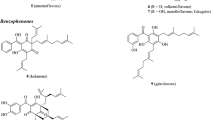Summary
Two African species ofAspilia (Asteraceae), which are used medicinally by man and which are eaten by wild chimpanzees in an unusual manner, were found to contain the potent antibiotic thiarubrine A as a major leaf phytochemical. Its presence in leaf material strengthens the view that the feeding behavior of wild chimpanzees is related to special physiological or pharmacological effects on the animals.
Similar content being viewed by others
References
We thank Dr P. Kuchar (Somalia) for the collection ofA. pluriseta. The work at the University of California was supported by the National Institute of Health (AI 18398 and AI 00472) and a UCI Research Travel Grant. The antibiotic studies at the University of British Columbia are financially supported by the Natural Sciences and Engineering Research Council of Canada.
Watt, J.M., and Gerdina, M., The Medicinal and Poisonous Plants of Southern and Eastern Africa. E. and S. Livingston Ltd, Edinburgh 1962.
Ayensu, E.S., Medicinal Plants of West Africa. Reference Public Press, Michigan 1979.
Wrangham, R., and Nishida, T., Primates24 (1983) 276.
Janzen, D., in: Arboreal Folivores. Ed. G.G. Montgomery. Smithsonian Institute Press, Washington, D.C. 1978.
Bohlmann, F., Gerke, T., Jakupovic, J., Borthakur, N., King, R.M., and Robinson, H., Phytochemistry23 (1984) 1673.
Bohlmann, F., Burkhardt, T., and Zdero, C., Naturally Occurring Acetylenes. Academic Press, New York 1973.
Bohlmann, F., and Kleine, K.M., Chem. Ber.98 (1965) 3081.
Norton, R.A., Finlayson, A.J., and Towers, G.H.N., Phytochemistry (1984) in press.
Turner, N.J., Bouchard, R., and Kennedy, D.I.D., Ethnobotany of the Okanagan-Colville Indians of British Columbia and Washington. British Columbia Provincial Museum, Victoria 1980.
Towers, G.H.N., Abramowski, Z., Finlayson, A.J., and Zucconi, A., unpublished results.
Kokwaro, J.O., Medicinal Plants of East Africa. Nairobi, Kenya (1976).
Yamahita, J., Primates4 (1963) 1.
Hasegawa, H., Kano, T., and Mulavwa, M., Primates24 (1983) 419.
Author information
Authors and Affiliations
Rights and permissions
About this article
Cite this article
Rodriguez, E., Aregullin, M., Nishida, T. et al. Thiarubrine A, a bioactive constituent ofAspilia (Asteraceae) consumed by wild chimpanzees. Experientia 41, 419–420 (1985). https://doi.org/10.1007/BF02004537
Published:
Issue Date:
DOI: https://doi.org/10.1007/BF02004537



